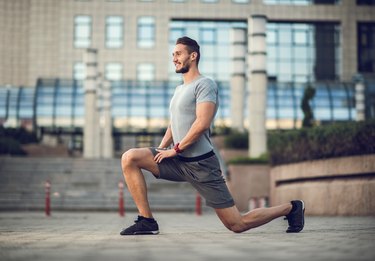
Lunges are one of the best exercises for your lower body. They're one of those staple moves, like squats or deadlifts, that are included in most people's leg day routine — and for good reason.
When it comes to strengthening your glutes and hamstrings, lunges are more effective than squats, according to the American Council on Exercise (ACE). Plus, this power move also works your quadriceps and calves and requires no special equipment — just your body weight!
Video of the Day
Video of the Day
Despite all these benefits, though, many people aren't getting the most out of their lunges, either because they're doing them incorrectly or because they don't know how far down to lunge. Here, fitness experts weigh in on the optimal lunge depth, as well as what you should do if you can't quite reach that.
So, How Deep Should You Lunge?
A basic forward lunge requires you to step forward and bend the front leg, while bending the back leg at the same time. But the big question is: How much should you bend your knees? Truth is, most people probably aren't lunging low enough to target their legs muscles properly.
Don't let your knee touch the ground, but it should come close, says certified personal trainer and nutrition coach Jonathan Jordan, CPT. "In general, I tell clients to strive for a 90-degree bend in both the forward and back knee," he says. "I tell them to try to get their back knee to 'almost kiss the floor' while keeping their front foot flat on the floor. [And] don't let that front heel pop up."
Jordan explains that this front lunge position, with your thighs parallel to the ground, is primarily working your quads. "In a front lunge, you want to try and use your forward leg as your power or pushing leg and your back leg for stability and support."
What if You Can't Do a Deep Lunge?
If you can't get that far down, it may be due to a lack of lower-body mobility, says Grayson Wickham, DPT, physical therapist and founder of Movement Vault.
"To perform a lunge to a deeper depth, you will need adequate hip-flexion mobility on your front leg, hip-extension mobility on your back leg, ankle-dorsiflexion mobility on your front ankle and big-toe extension on your back foot," he says.
If your hip, ankle or even big toe has decreased flexibility, that can affect your ability to do a deep lunge. You should continue doing lunges, but with a few modifications, as they'll actually help increase your flexibility to reach that optimal lunge depth.
"While descending downward into your lunge, focus on moving straight down, allowing your back knee to move downward as close to the ground as your mobility allows," says Wickham. "If you can't maintain good form, you are most likely going too deep into your lunge or you have your feet too far apart from each other from front to back."
The solution? Take a more narrow stance and go down as far as you can, Wickham says. Then, as your mobility improves, widen your stance.
"If you try to perform an exercise through more range of motion than your joints currently have, you will cause compensations in these and other joints, which can and usually do lead to joint wear and tear and eventually pain and injury," he says.
Tip
A narrow stance lunge improves the flexibility of your ankle, while a wide stance lunge improves the flexibility of your back hip. You'll feel a stretch in these areas during your lunge.
Tips on Perfecting the Lunge
Knowing proper form is only one part of the equation; putting it into practice is the other. One way to make sure your know-how carries over into your workout: "It can be helpful to do lunges in front of a mirror so you can check out your front knee," Jordan says.
Make sure your knee stays in line with and directly over your ankle and doesn't collapse inward, he says. If balance is a problem, make sure you're engaging your core. You can also place a pad or cushion on the floor as a target for your back knee to land on at the bottom, which is especially useful if you're working on hard flooring.
Or if you have knee pain, do a forward leaning lunge with your upper body tilting slightly forward, recommends the National Academy of Sports Medicine. This distributes your weight more evenly in your hip and knee and takes the stress off your knee.
Try These Lunge Variations
You don't have to stick to only doing forward lunges. Changing up your stance challenges your muscles in different ways.
"You can switch between a wide- and narrow-stance lunge during the same workout or on separate workout days," Wickham says. "Switching your stances place a different emphasis on specific leg muscles, as well as different mobility requirements."
A wide-stance lunge works your glutes and hamstrings more, while a narrow-stance lunge places more emphasis on your quadriceps, he says.
Jordan also recommends adding resistance to your lunges by holding dumbbells or a barbell or by adding a pulse (tiny movement up and down) at the bottom of your lunge. If you're having knee pain or having difficulty with balance, opt for a reverse lunge (in which you step back instead of forward) to take some pressure off your knee.
"I suggest clients do a mix of both reverse lunges and forward lunges (sagittal plane) and then layer in lateral (frontal plane) and curtsy (transverse plane) lunges," he says. "If you can perform lunges in all three planes of motion pain-free, you are officially winning at life!"